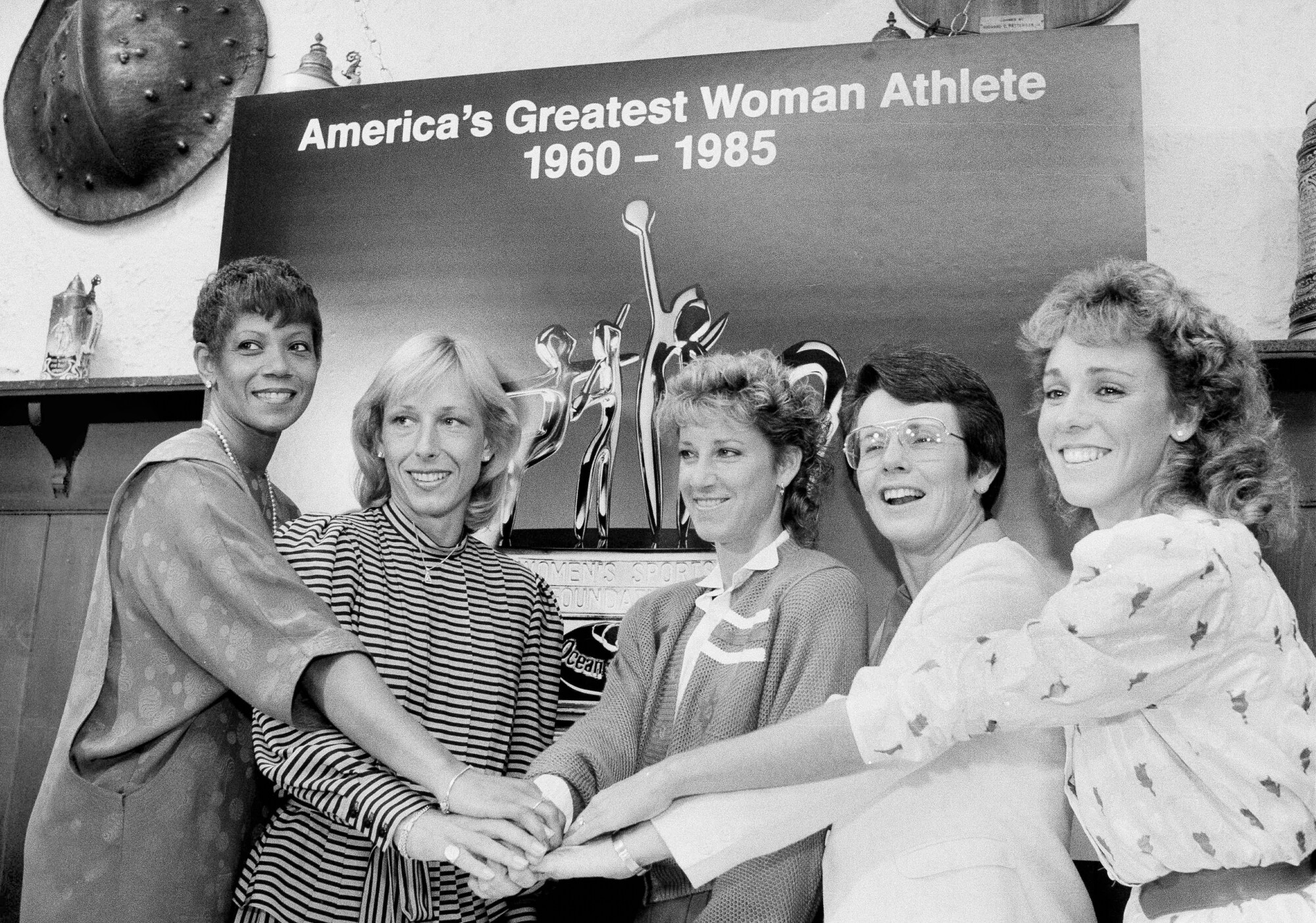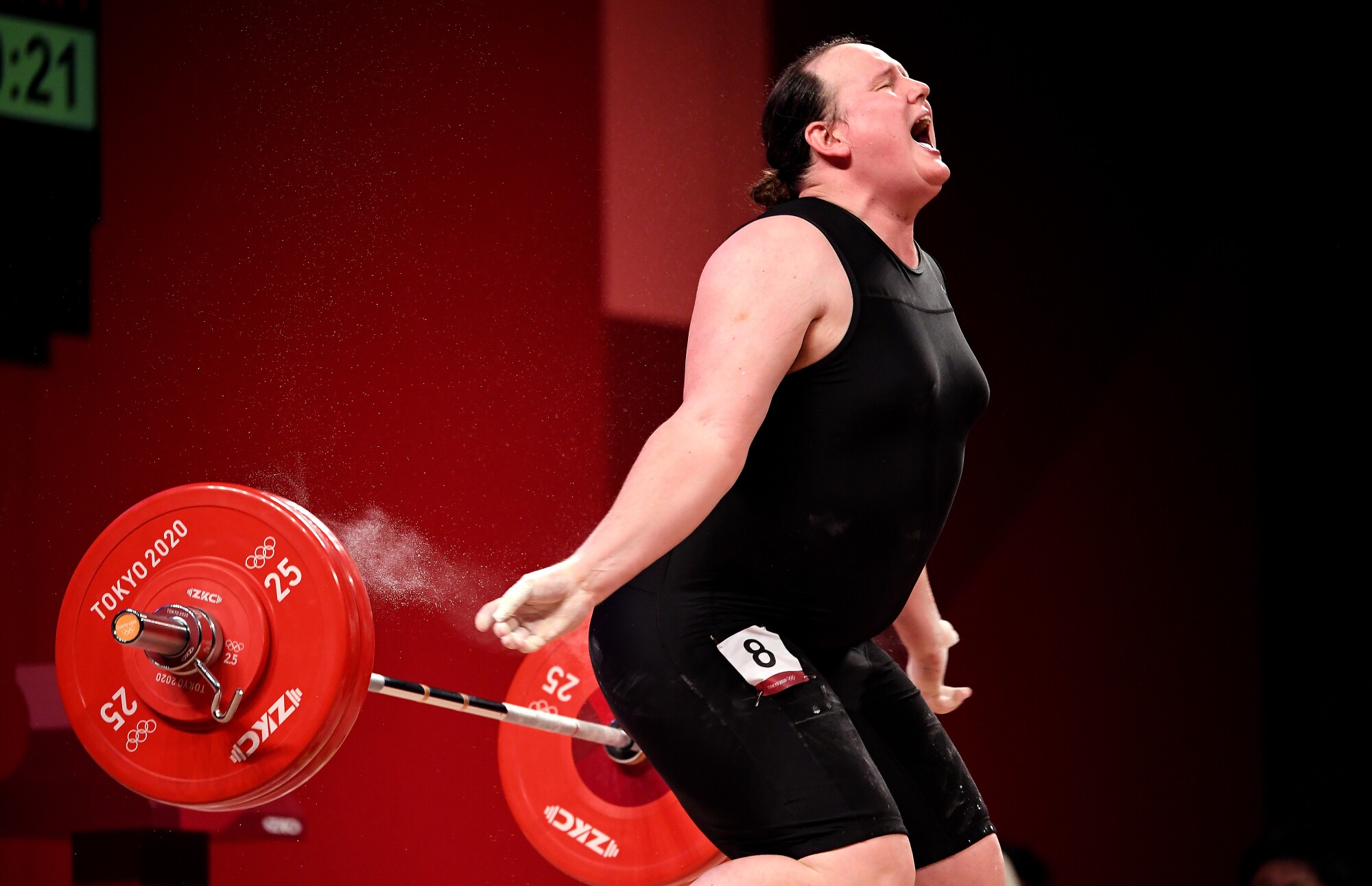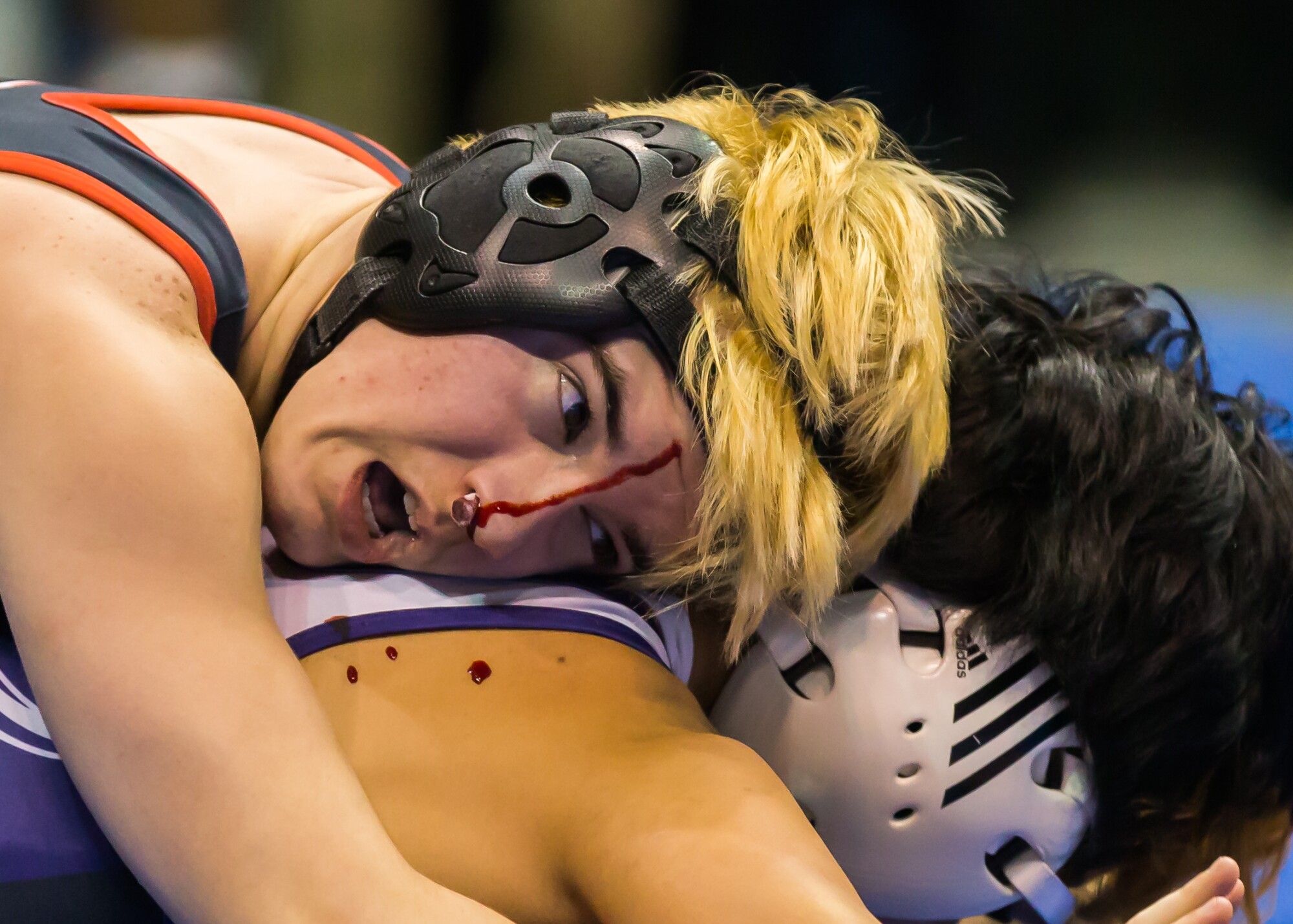
As Title IX turns 50, it plays a surprise role in transgender athlete access debate
On the spring day when Lia Thomas made history by winning an NCAA swimming championship as a transgender female, protesters gathered outside the arena to do what protesters normally do. Chant. Wave signs. Wear T-shirts with slogans.
“Support fair sports,” they yelled.
Thomas, who transitioned in college, was too fast, too strong, too male to race against cisgender women, they insisted. Their complaint was typical of a backlash that has grown louder as transgender female athletes become more common and successful.
Critics have raised all the predictable issues regarding fair play, biology and gender identity. In demanding stricter eligibility rules and separate categories for transgender women, they have latched onto an unexpected justification.
Title IX.
The federal law, which celebrates its 50th anniversary this week, has long been synonymous with inclusion but now must account for a constituency that wasn’t part of the conversation in 1972.

TITLE IX: 50 YEARS LATER
Title IX, the law that mandated equal access to activities for girls and women at federally funded schools, celebrates its 50th anniversary on Thursday, June 23. The Women’s Sports Foundation states girls have enjoyed 3 million more sport opportunities since Title IX was passed, but they still have 1 million fewer chances to play competitive sports than boys.
The argument goes like this: Every time a transgender woman earns a roster spot or wins a medal, she is denying her cisgender opponents of a federally protected opportunity. More than a dozen states have passed laws banning transgender females from girls’ and women’s competition through high school and, often, college.
“This legislation is just a way to honor those people who worked hard to get Title IX,” said Wendy Schuler, a Wyoming lawmaker and former college basketball player who sponsored legislation in her state. “For 50 years we’ve had the opportunity to compete as females and I just would hope we continue that fight.”
For many women who have struggled to achieve athletic equality, the issue feels urgent. For the transgender community, it is agonizingly personal.
LGBTQ advocates worry about so much scrutiny focused on so few athletes — transgender males usually don’t figure into the discussion because they don’t win as often. Limited research, the advocates say, has yet to prove unfair advantages for transgender females.
The athletes themselves wonder why a law designed to foster participation is cited not only to exclude them, but also to question their essence.
“We’re talking about female athletes,” said Veronica Ivy, a transgender cyclist and former world champion in her age group. “Title IX cannot be used as a wedge against trans women — they are female.”
Title IX isn’t just about sports — it was drafted to protect against sex discrimination in all programs and activities at schools receiving federal funds. Yet athletes have been a focal point from the start.
“You can never understand inclusion, until you’ve been excluded,” former tennis star and LGBTQ advocate Billie Jean King has said. “Today, because of Title IX, things for women are different.”
More than 3.6 million females now compete in high school and college — a ten-fold increase from 1972 — according to the Women’s Sports Foundation. Still, there is a lingering gap in opportunities.
The transgender community became part of the Title IX discussion in 2016 when the Obama administration issued a “Dear Colleague” letter advising that protection against sex discrimination should include gender identity. The Trump administration rescinded the policy directive in 2017, only to have President Biden reinstate it last year.
“It’s very clear under this administration … and I believe that is actually the way the law should be interpreted,” said Felice Duffy, a Connecticut attorney who specializes in Title IX cases. “But there’s a problem with having Title IX apply to sports.”
The glitch involves a type of segregation illegal in, say, housing or the workplace. In sports, “separate but equal” is considered essential because men tend to grow larger, stronger and faster than women.

After being nominated for the greatest U.S. woman athlete during a Women’s Sports Foundation event in 1984, from left, Wilma Rudolph, Martina Navratilova, Chris Evert, Billie Jean King and Mary Decker pose together in 1984.
(Marty Lederhandler / Associated Press)
A group of former athletes and sports administrators headed by tennis great Martina Navratilova and Olympic swimmer Nancy Hogshead-Makar recently made this case in a petition delivered to Congress.
“Separate sports for males and females are necessary to assure that females have the same opportunities as males to participate, to win, and obtain scholarships, prize money, publicity, honor and respect,” the petition stated. “No matter how talented and hardworking, female athletes generally will not be able to outperform males as a group.”
The Women’s Sports Policy Working Group — not connected to the Women’s Sports Foundation — told legislators that, in many cases, transgender females also hold “sex-linked physical advantages” and should not be permitted to compete head-to-head with cisgender women.
The idea of regulating transgender competition is acceptable to some LGBTQ advocates, but only in certain events at high levels of sport. The problem is where and how to draw the line.
This dispute triggered the protest outside the NCAA swimming championships and similar pushback at the Tokyo Games last summer when weightlifter Laurel Hubbard of New Zealand became the first openly transgender female Olympian.
“I know that my participation at these Games has not been entirely without controversy,” Hubbard told a throng of reporters after finishing last in the finals.

New Zealand’s Laurel Hubbard, the first transgender Olympian, competes in the women’s +87kg weightlifting final at the Tokyo Olympics in August.
(Wally Skalij / Los Angeles Times)
Even on a smaller stage, the issue has prompted lawsuits. Alliance Defending Freedom, a conservative advocacy group, filed on behalf of cisgender athletes who raced against two transgender female sprinters at the Connecticut state high school championships. A transgender girl in West Virginia also sued, claiming her rights were violated when she was denied a tryout for her middle school’s cross-country team.
“I just want to run,” Becky Pepper-Jackson said. “I come from a family of runners.”
Both sides of the argument can choose from various, limited studies. Both sides insist they have scientific proof.
A transgender sports ban working its way through the Ohio state legislature would require any athlete whose gender is disputed to provide, among other things, a physician’s statement regarding “external reproductive anatomy.”
The proposal harkens back to an era when female athletes occasionally had to undress for visual examination. Officials later switched to a cheek swab, checking for the inactive X chromosome that typically presents in women, a standard dropped because it failed to account for rare conditions.
The sports world has now settled on measuring testosterone, the hormone responsible for strength and mass. Men have higher levels, so transgender females — and women with “differences of sex development,” such as South African runner Caster Semenya — must undergo hormone therapy to lower their levels to the female range.
“There is very little doubt that the single most important differentiating factor between male athletes and female athletes is testosterone,” said Joanna Harper, a transgender runner and researcher at Loughborough University in England. “Anyone who tries to make you believe otherwise is obscuring facts.”
The International Olympic Committee, NCAA and other organizations have relied on various federations and governing bodies for each sport to set appropriate benchmarks. In track and field, and figure skating, officials require transgender females to maintain a testosterone level below five nanomoles per liter for 12 months prior to competition. In softball, the standard is 10 nanomoles per liter.
International swimming officials went a step further Sunday, enacting a “gender inclusion policy” that effectively bans transgender females, allowing only those who transition by the age of 12. The federation based its decision on the concept of “legacy” advantages.
Some researchers believe that transgender females who begin hormone therapy after puberty have already benefited because their bodies developed without mitigation. During a recent video conference, South African sports physiologist Ross Tucker asked: “Does the fix work? If you lower the testosterone, do we take away the advantage?”
The question of “legacy advantages” is essential to Hogshead-Makar, who spent the 1970s and ‘80s swimming against East Germans subsequently caught doping. She later became an attorney and founded “Champion Women,” a nonprofit organization that advocates for Title IX rights.
“There are a few places where biology actually matters,” she said. “If you want to give women equal opportunities in sport, they need to have their own team.”

Nancy Hogshead-Makar, who won four Olympic medals swimming for the United States in 1984, believes there needs to be a separation of men’s and women’s sports.
(David Zalubowski / Associated Press)
But the science is not so clear-cut because testosterone provides more advantage in some sports, less in others, and research has shown some females have natural levels overlapping the lower end of the male range.
Performance could be influenced by a range of physiological factors, requiring additional research to shape sports policies and Title IX decisions.
Even Harper, who says “No one has spent more time looking at transgender athletes than me,” pauses when asked if testosterone is the best determinant.
“Given the level of science we have now? Yes,” she said. “Will it always be? Probably not.”
At the intersection of transgender athletes and Title IX, she worries partisan bias can overwhelm evidence-based debate.
“Once you get politics involved, it becomes really hard,” she said.
It should come as no surprise that the conflict over transgender female athletes is cast as an existential struggle. Susanne Lyons, chairwoman of the U.S. Olympic & Paralympic Committee, recently said: “Our values of fairness as well as the right to compete … are a bit at odds.”
Transgender tennis player Renee Richards first raised concerns when she sued to enter the 1977 U.S. Open, where she lost early in women’s singles but made the doubles final. Her participation sparked a new debate over the definition of fairness.
Researchers apply data to a less-than-empirical concept that Harper calls “meaningful competition.” In other words, all athletes possess different physiologies, but when does the disparity become unfair?

Renee Richards competes during a women’s tennis tournament in Newport Beach in February 1978.
(Kerry Coughlin / Associated Press)
Left-handed batters have a slight advantage over right-handed batters in baseball, yet they play together. Heavyweight boxers, however, do not fight middleweights.
“The bigger boxer wins every time,” Harper said. “There is no meaningful competition.”
That is why transgender regulations differ from sport to sport. Hogshead-Makar prefers another set of statistics based on participation — no matter the game, she sees a zero-sum equation with transgender females potentially taking an unfair slice of the Title IX pie.
Without regulation, she said, “we won’t have women’s sports anymore.”
Transgender advocates point to a third set of numbers. The IOC first issued transgender guidelines in 2003, yet it wasn’t until 2021 that Hubbard became the first openly transgender female athlete. It took nearly a decade of NCAA competition for transgender hurdler CeCe Telfer to win a Division II championship, followed soon after by Thomas in Division I swimming.
“If you say, like, you can compete, but you can’t score or you’re in an extra lane nine, that’s very othering towards trans people.”
— Lia Thomas, transgender swimmer
“The idea of fairness is really a red herring,” Ivy said. “When we compare trans women with cisgender women, even if we suppose some amount of competitive advantage, it’s not unfair.”
No one sought to bar Kareem Abdul-Jabbar from the NBA because of his height, advocates say. No one protested Usain Bolt’s eight Olympic gold medals because of his extraordinary stride length and frequency in the sprints.
“To be honest, every Olympic gold medalist is a biological freak,” Ivy said, adding that she means that as a compliment. “That’s what it takes to win at that level.”
Ivy, a Canadian athlete and now an activist and researcher, faced criticism after transitioning as an adult and winning a 2018 world masters title under the name Rachel McKinnon. Navratilova equated her victory to “cheating” and Donald Trump Jr. called it “BS.”

Canadian cyclist Veronica Ivy celebrates after winning a sprint final at the 2019 UCI Track Cycling World Masters Championship.
(Oli Scarff / AFP via Getty Images)
Ivy compares transgender sports bans in numerous states to previous efforts by conservative groups to outlaw gay marriage or regulate transgender access to public bathrooms.
“When those backfired, they shifted to sport,” she said. “Not because they care about sport, but because they think they’ll be more successful.”
Harper expresses similar frustration based on polling data.
Recent polls show that 0.7% of Americans identify as transgender. With about 220,000 women competing in NCAA sports last year, that should have translated into 1,500 transgender female athletes, but the actual number was believed to be far lower.
“This idea that trans women are going to take over sports — not going to happen,” Harper said. “It’s important that people not get super-excited when one trans woman starts winning.”
Earlier this year, Utah Republican Gov. Spencer Cox vetoed a transgender sports ban because, among other things, his state had only four transgender athletes among 85,000 school kids.
“Four kids who are just trying to find some friends and feel like they are part of something. Four kids trying to get through each day,” Cox wrote. “Rarely has so much fear and anger been directed at so few.”
The Republican-dominated Utah legislature, citing a need “to uphold Title IX,” overrode his veto.
Among all the arguments for regulating transgender athletes, one leaves the transgender community particularly dumbfounded — the fear that athletes might transition, changing their names, changing their bodies with hormone therapy, simply to win.
Advocates point to the 2017 case of Mack Beggs, a high school wrestler who began taking testosterone while transitioning from female to male. Though hormones made him stronger, he was forced to keep wrestling against girls because of a Texas policy that classified athletes by the gender listed on their birth certificate. Beggs, who won consecutive state titles, would rather have competed against boys.
“If I get beat, I get beat,” he told ESPN, adding that “it just makes more sense.”

Mack Beggs competes despite dealing with a nose bleed during a girls Texas high school state tournament in February 2017.
(Leslie Plaza Johnson / Icon Sportswire via Getty Images)
The Women’s Sports Policy Working Group says it believes there is “a middle way” to settling such conflicts while providing for inclusion. The group supports national testosterone standards, plus additional rules for “legacy” advantages it believes cannot be addressed by hormone therapy.
In some cases, transgender athletes might be put in separate events or allowed to compete beside cisgender opponents but with separate results and medals. The proposal has met with opposition.
There might not be enough transgender females in a given school — or a given state — to form a soccer team or fill a 100-meter sprint field, LGBTQ advocates say. Adding lanes to a swimming race, for example, might have unintended consequences.
“If you say, like, you can compete, but you can’t score or you’re in an extra lane nine, that’s very othering towards trans people,” Lia Thomas told ABC News. “And it is not offering them the same level of respect and opportunity to play and to compete.”
Chris Mosier, a transgender male triathlete and activist, agrees that sports influence how transgender people are treated in other areas of life. He finds it “heartbreaking” to quarrel with the likes of Navratilova and Hogshead-Makar.
“These incredible women athletes who have had an impact on making sure that young women and girls can participate in sports — they have been on the right side of history in that way, but now have turned against the trans community,” he said.
Transgender advocates oppose any regulation before high school, when no college scholarships or state championships are at stake. The Women’s Sports Foundation goes a step further, calling for unrestricted participation through 12th grade.
All of this might sound reasonable to parents — until their cisgender daughter loses a race or a starting role to a transgender girl.
At her law office, Duffy fields calls from potential clients on both sides. Years ago, as a student, she filed a Title IX complaint to create a women’s soccer team at the University of Connecticut but now doubts that federal law is the solution.
“The younger generation is much more open,” she said. “Get high school kids to come in and talk about it. They can probably figure it out.”
For all the disagreements over data, all the suspicions and hurt feelings, people on polar ends of the transgender issue remain optimistic. Hogshead-Makar hopes cooler heads will prevail and Harper trusts science to find a better metric.
Even Ivy has hope. Though the situation might “get worse before it gets better,” she expects transgender women to achieve equality someday. Just like cisgender women did when they fought for Title IX 50 years ago.
Stay connected with us on social media platform for instant update click here to join our Twitter, & Facebook
We are now on Telegram. Click here to join our channel (@TechiUpdate) and stay updated with the latest Technology headlines.
For all the latest Sports News Click Here
For the latest news and updates, follow us on Google News.

